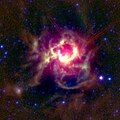This article includes a list of general references, but it lacks sufficient corresponding inline citations .(November 2017) |
| NGC 1624 | |
|---|---|
 Image of NGC 1624 with the Isaac Newton Telescope Credit: IGAPS | |
| Observation data (J2000 epoch) | |
| Right ascension | 04h 40m 36.0s [1] |
| Declination | +50° 27′ 42″ [1] |
| Distance | 20000 ± 2000 ly (6000 ± 600 pc [2] ) |
| Apparent magnitude (V) | 11.8 [1] |
| Physical characteristics | |
| Estimated age | <4 Myr [2] |
| Other designations | Cr 53, C 0436+503, OCl 403, Tribble Nebula, Little Cocoon Nebula |
| Associations | |
| Constellation | Perseus |
NGC 1624, also known as Sh 2-212 [3] in the Sharpless catalog, is a very young open cluster in the constellation Perseus inside an emission nebula. It was discovered by German-British astronomer William Herschel in 1790. [4] Together with Sh 2-211, this nebula is part of the Tribble Nebulae. [5] NGC 1624 is about 20,000 ly (6,000 pc) from Earth, and latest estimates give it an age of less than 4 million years. [2] Its apparent magnitude is 11.8, [1] and apparent diameter is about 3.0 arc minutes. [4] Its celestial location is right ascension (α) 04h 40m 36.0s and declination (δ) +50° 27′ 42″. [1] It is potentially an area of massive star formation. [6]
Contents
According to Robert Trumpler's classification of open clusters, this cluster contains fewer than 50 stars (letter p) with a high concentration (I) and whose magnitudes are distributed over an average interval (number 2). The letter n at the end (I2pn) means that the cluster is inside a nebula.

